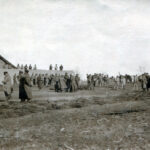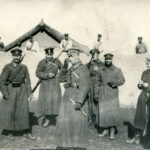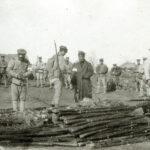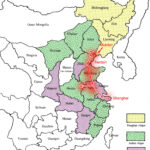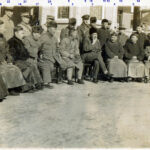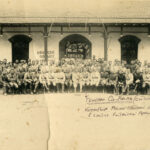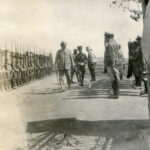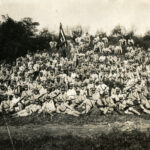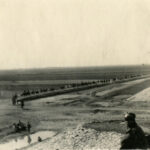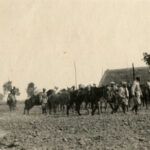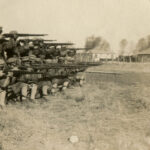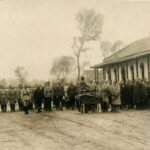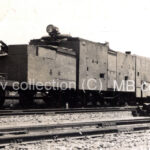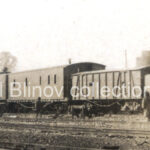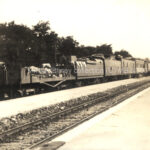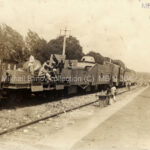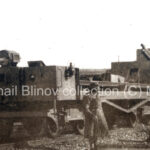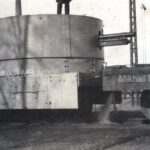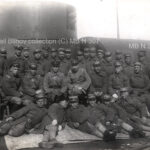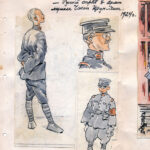Mikhail Blinov “Russian Detachment in the Chinese Service 1924-1928“. Part 1: History, weapons, uniforms and awards. Part 2: Marshal Zhang Zuchang’s Russian Armored Train Division. Based on own archival materials from Paris and San Francisco, as well as the memories of the participants in these events.
Introduction.
Some encyclopedias and even the books on the history of the Chinese Civil War erroneously cover the period only from 1927 to 1949, that is, the armed conflict between the Kuomintang and the Communist Party, although they indicate the “prehistory” of these events. We adhere to the classification of the period from 1911 to 1949, as described in the excellent book “The Chinese Civil War Armies 1911-1949” by Osprey (Philip Jowett, the author and Stephen Andrew, the Illustrator). Based on our own archival documents from Paris and San Francisco, as well as the memoirs of the participants with whom we knew personally, we begin to post the history of the hostilities from 1924 to 1928. Formally, these are considered as the coalition wars and are called: Second Zhili–Fengtian (1924), Yunnan–Guangxir (1925), Anti-Fengtian (1925–26) and finally Northern Expedition (1925–1928). However, this period of the Chinese Civil War has a number of interesting features and shows the international nature of these events.
In October 1922, the Civil war in Russia ended with the victory of the communists, and the White army of Admiral Kolchak was forced to withdraw to Chinese territory, surrender their weapons and settle in the refugee camps Kirin and Changchun. The border crossing was carried out in Manchuria, which was used by the governor of the three northern provinces, Marshal Zhang Zuolin, who has old ties with the Russian army. Russian troops gave for the money or sometimes for free, the weapons and the ammunition, including the artillery, the machine guns, the rifles of the various types. In 1923, the recruitment of the former officers and soldiers of the Russian White Army who were in military refugee camps to serve in the Chinese army had already begun, primarily the artillerymen, the machine gunners, the cavalrymen and the engineers. Thus, by 1924, a Russian volunteer detachment was formed under the leadership of General Nechaev as part of the troops of Chang Tsung-chang (Zhang Zongchang) warlord.
The main battles with varying success were between the “north” and “south”. At the same time, the “southern” group was considered pro-communist, where there were Soviet specialists and instructors. In addition to instructors, the Soviet Union also supplied the “southerners” with weapons, as evidenced by the trophies taken by the “northerners” with the hallmarks “Made in Moscow” and the corresponding dates of the 20s. Thus, the conflict between the northern and southern coalitions became international and, in fact, a continuation of the civil war in Russia.
Initially, the Russian detachment was a powerful armed force of well-trained soldiers and officers with combat experience on the fronts of two wars: the First World War and the Civil War. The armored trains built by the Russians were used as a shock unit to fight against the “southerners”. In total, more than 14 Russian armored trains were made only in the army of warlord Chang Tsung-chang; (Zhang Zongchang). “Southerners”, under the guidance of the Soviet instructors, not only opened a military school, but also taught the tactics of “rail war”, which was later used in 1941-1945. By 1927, the significance of the Russian detachment had become insignificant, and the split of the “southerners” into “nationalists” and “communists” caused the loss of the ideological meaning of the Russian service. In 1928-1929, the Russian detachment was finally disbanded, most of the people returned to the cities of Harbin and Shanghai, and only a small part entered the service of the troops of the “southerners”, who after 1927 became the enemies of the communists. In these battles, about 2000 Russians died, who were mostly buried in a special cemetery in the city of Tsinan (Jinan), the base of the detachment.
Before the Second World War, the former fighters of the Russian detachment remained in Harbin, where many collaborated with the Japanese occupation forces and served in the Manchukuo army. After the occupation of Manchuria by the troops of the Red Army, they were all killed or sent to the NKVD camps in Siberia. The fighters of the Russian detachment, who left for international Shanghai at French concession, entered the service of the Shanghai Volunteer Corps or the municipal police. As the Chinese communist army approached in 1949, Russian refugees were evacuated to the island of Tubabao (Philippines), the DP camp, and then to the USA and Australia. A small part of the refugees went to France. These last fighters of the Russian detachment in the city of San Francisco, California, USA, joined the local Society of Veterans of the Great War. The last editor of the Veterans Society magazine in the late 90s and early 00s was Mikhail Blinov, who writes this article. The editors of the magazine collected the preserved archival documents, the photo albums, and also made a video recording of the memories of the last members of the Russian Detachment at the Chinese service. The first publications of those memoirs were published in the magazine “Vestnik ORVVV” in Russian during 2000-2003. After the closure of the magazine in 2008 and the author’s move to Paris, all publications began to be published in electronic form on the website at the special guidebook section.
Below we place the background information on the history, the weapons, the uniforms and the awards of the Russian detachment in the Chinese army service under warlord Chang Tsung-chang (Zhang Zongchang) in 1924-1928.
The particular interest are the armored trains of the Russian detachment, built in the workshops of the Tsinan (Jinan) city. This topic is little studied, there is an inaccurate information on the international historical forums, and we place our e-book about the armored trains in a separate section. We have great respect for the research of the historian Steven J. Zaloga and his wonderful book “Armored Trains”, also published by Osprey Publishing. In fact, our work is an addition and extension of this remarkable author-researcher. Without pretending to be complete information, we place the main history of the Russian armored trains of warlord Chang Tsung-chang (Zhang Zongchang), without touching on a small number of armored trains built by other governors of the northern coalition, and even more so by the troops of the southerners.
Part 1.1. The origin of the detachment and the campaign September 1924 – March 1925 against Wu-Peifu
In the autumn of 1924, a Russian detachment was formed under the command of Lieutenant General Nechaev in the city of Mukden. The detachment was part of the 1st Mukden Army, as part of the brigade of General Zhang Zuchang. Initially, the detachment consisted of: 2 machine gun companies, a battery, a squadron and a machine gun company, numbering approximately 300 people. At this time, Mukden started a war with Marshal Wu Pei-fu.
The mountain campaign against the southerners through Jehol and going through the Great Wall of China to the deep rear under the Lanzhe-fu station was the beginning of the battles of the Russian detachment, which was later deployed into the 1st separate brigade of the Mukden troops. After successful battles at the Lanzhe-fu station and taking large trophies, including guns and trains, the detachment built the first armored train in one day, as it was during the civil war in Russia. Guns and sandbags were placed on railway platforms. Later, they began to armor cars in workshops and make real armored trains. Three platforms with airplanes and two wagons of silver money were also captured here. The Russian armored train moved on and captured the important city of Shanhaiguang with even more trophies. Further, the Russian brigade moved against the troops of Wu Peifu and captured the city of Tianjin before Christmas. Further, the brigade moved south along the Tianjin-Pukou railway and fought in the area of the city of Nanjing. Reinforcements were received in the cavalry and other armored trains were built.
- Hunchun city, Russian army crossing the Chinese border, November 1922
- Chinese garrison of Hunchun Fortress
- Disarmament of the Russian army, surrender of the rifles, November 1922
- Lieutenant General Konstantin Nechaev
At the beginning of 1925, the Qianing fortress and the city of Shanghai were taken, General Chi-bi-wen, an ally of Wu Peifu, fled to Japan, and a truce was concluded with Song Chuanfang. In six months, a handful of Russian volunteers defeated the troops of the “invincible” Wu Peifu and raised the status of Zhang Zuoling, making him the main candidate for the leadership of China.
The truce at the front March – October 1925 and the fight against the hunghuz
The 1st Russian brigade spent the spring and summer of this year in the city of Taian, which is located next to the beautiful mountains. Large gangs of hunghuza were located in this area, against which Russian detachments were sent. Despite a major military operation, Russian losses were small. The commander of the brigade, General Nechaev, according to the old national tradition, drank all this time.
- Map of the battles of the Russian detachment for 1924-1925
- Map of the battles of the Russian detachment in 1926 – 1927
Battles in the period October 1925 – April 1926
In October 1925, Song Chuanfang’s troops attacked Mukden’s troops and the truce ended. The Russian detachment numbered 1200 people, was in the service of Zhang Zuchang and began to fight against Song Chuanfang and the old enemy Wu Peifu at the same time. The main battles began in the Kaifeng region (see map) – this is a side branch of the Jinan – Pukou railway, as well as near Suzhou. In November, after the start of the campaign against Marshal Sun Chuan-fan, large increases in Russian units began in the army. Armored trains were allocated to a special group, the formation of a special detachment began. The Shandong military school (for junkers of Russian nationality) is opened, an engineering division is formed, as well as a personal escort of Marshal Zhang Zu-chang.At this time, the Russian detachment already consisted of several armored trains that actively participated in these battles. 4 armored trains were destroyed by a land mine and a dismantled bridge. On the basis of the detachment, in the city of Jinan, new 4 armored trains began to be built to replace the destroyed ones.
In February 1926, a Russian detachment, including new armored trains, was transferred to the northern front. They take Tianjin in March, and Beijing in April and defeat Feng Yuxiang. After the defeat of Fyn and Wu-peifu, a truce began in May 1926 until February 1927.
The structure of the Russian detachment (October-November 1926)
65th Division 3rd Army (former Vanguard Group of Mukden Forces)
(Chief of the Division – Major General of the Chinese Service Konstantin Nechaev)
– 166 Infantry Brigade (Major General Makarenko):
— 105 Mixed Regiment
— training company of junkers (Major Shtin)
– another regiment is being formed (? 106)
Artillery:
– ? Battery (at what unit part): 4 Krupp mountain guns
– Separate battery – 1 Arisaka
– Cavalry brigade (the commander himself is the head of the division):
— 2nd Horse Regiment (Semenov)
— a separate Horse division (? Bychkov)
– Armored division:
— 1 brigade (Major General Chekhov)
— armored trains “Beijing”, Taishan”
— 2 Brigade (General Liu Shian)
— armored trains “Honan” (Repchansky), “Shandong”
— 3 Brigade (General Yang Tayu)
— “Chang Chen” (Great Wall), “Chang Jen” (Great River)
– Military Instructor School (Tarasov)
– Cavalry Hundred of escorts (former personal escort) of Zhang Zu Chan (Tanaev)
Battles in the period February – December 1927
In February 1927, the division was again at the front against Canton. The fighting went on intermittently until June, when the division comes back to Jinan. In the summer of 27, the division was disbanded and the 105th and 106th regiments formed the 109th brigade, and the cavalry regiment and the cavalry division. Bychkov cavalry brigade (2nd and 4th cavalry regiments). In October, the brigade went to the front in the Honan province.
Russian units after reformation (October 1927), subordination of General Chekhov:
– 109 Russian brigade (general m. Sidamonidze), of 65th division:
— 105 Infantry Russian regiment (colonel Tarasov)
— 106 Russian regiment (colonel Sharapov)
(The regiments have a three-company and 3-battalion composition, German-style rifles)
– 7 special regiment (from graduates of the Military School, from 3 types of troops: infantry, cavalry, artillery. Commander Colonel Kvyatkovsky)
— rifle battalion (3 companies)
— technical battalion: machine gun company, bomb company, grenadier company
— consolidated battalion: squadron, artillery battery, sapper company.
(regiment up to 800 people, Chinese with Russian instructors, Russian 100 people).
– Quartermastership Tsinan garrison
– a separate officer company, 100-120 people.
– Division of armored trains:
— 1st detachment (commander Chekhov himself): “Beijing”, “Taishan”
— 2nd detachment (Zagaily): “Chang Jen”, “Chang Chen”
— 3rd detachment (Mrachkovsky): “Henan”, “Shandong”
Attached unit at the division:
— armored train engineering company of 50 people. (Regiment Engineer Sakulinsky). The company is in charge of repairing and building armored trainsю
Separate parts (not subordinate to General Chekhov):
– cavalry brigade (General Semenonv):
— 2nd Cavalry Regiment (Commander Colonel Manzhetny):
— 4 squadrons and a machine gun team (5 serviceable Colts), 300-350 sabers, armed with Russian-style carbines and rifles, officers with Mausers.
— 4th Cossack regiment (colonel Saraev)
3x hundreds of personnel, 4th formed, machine gun team 4 Colts.
– a horse-mountain artillery battery was attached (on a campaign)
Commander Major Moskalev, 2 “hubei” (lightweight gun).
Tupan units (Gov. Zhang Tzuchang):
– Convoy hundred (Colonel Tanaev), 160 people
– Officer-instructor company (former detachment of junkers)
80-100 people completed almost 2 years of training
– Formation of the Russian railway battalion for the Chinese, commander Colonel Engineer Ivanov.
In January 1928, the 109th brigade was disbanded. Remained: armored trains, a cavalry brigade and a marshal’s convoy. Russian group, composition for August 1928:
1st division of Armored Trains (General Mrachkovsky)
— “Menji-ho” (formerly “Shandong”), Colonel Kuklin
— “Yu-Kui” (formerly “Henan”), Lieutenant Colonel Kotelov
— “Chan-Chen” – (Colonel Kotlyarov),
— “Chen-Dyan” – (Major Savin)
2nd division of armored trains (General Makarenko), 150 people:
— “Zhili” (Lt. Col. Schneider), “Hu-Guan” (Colonel Rechansky)
– Cavalry detachment of General Semenov
Number -350 people, 5 hundreds, fifth – technical (2 mountain guns and machine guns) The detachment is renamed into a regiment
– Convoy cavalry hundred of Colonel Tanaev 150 people
– Detachment of General Pykhalov 30 hours.
Final and disbandment. In October 28, as a result of the conflict between Marshal Zhang Zu-chan and Mukden, the existence of the Shandong units ended, and with it the Russians. Three armored trains and a cavalry brigade were disarmed by the Mukden units, and the marshal’s convoy and three other armored trains were disarmed by the southerners. During the existence of the Russian group, the loss of more than 1800 people, most of them are buried in a cemetery in the city of Jinan.
- Governor Zhang Zongchang, his staff and local clergy (N 086)
- Generals Nechaev, Sidamonidze and staff (N 271)
- Nikolay Merkulov’s meeting at the headquarters (N 147)
- 2 cavalry regiment with banner (N 035)
- View from the armored train turret on the column of the cavalry regiment and the surroundings (N 147)
- Parking lot of the cavalrymen and the horses (N 151)
- Volley shooting practice near the barracks (N 154)
- Funeral service for the dead, Orthodox priest, military camp in Jinan (N 182)
Russian armored trains of Shandong province made in China
Armored trains built in the Russian detachment of Marshal Zhang Zuoling in the workshops of the city of Tsinan (Jinan) in Shandong province in 1925-1928. Separate single armored trains built in 1927-1929 by other marshals, allies of Zhang Zuchan in the northern coalition in other provinces, are not included in this section.
- The first armored trains of the early “box” type (? “Chang Cheng” = Great Wall) 1925 Tsinan depot (N301 P391)
- The first “box” early type of armored trains before rebuilding, presumably “Henan” and the “Chang Cheng” (Great Wall), 1925 (N302 P506 fragment)
- Armored train “Henan” after modernization (N 303)
- “Box” cars before modernization, compare with other photos (N 304)
- Armored train “Henan” (MB N 305 P507)
- “Beijing” 1926 or 27, is the best armored train modeled like the First World War (“Hunhuz”), also known as the Czech “Orlik” (N 306)
- Armored train “Peking” (“Beijing”) and its crew, 1926 or 1927. Pay attention to the armor near the machine gun loopholes (N 307)
- White Russian Armored trains, the history, description and pgotos
to be continued soon..
- Russian detachment uniform in the Chinese army, cartoon
To be continued, with the additions and the corrections..
This publication is preliminary, there will be the changes, the clarifications and the additions related to the inaccurate sources information and the complexity of the translating Russian names into Chinese and English. The author would be grateful for any help in clarifying this reference. The errors, mistakes and the problems in the names of the armored trains are associated not only with the distortion of the words by Russian officers, but also with the fact that Russians wrote individual words according to a the different, not Chinese scheme, but from left to right.


